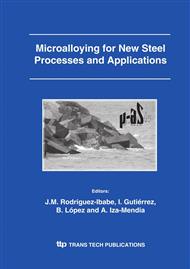[1]
J.J. Jonas: ISIJ Int. Vol. 40 (2000), p.731.
Google Scholar
[2]
J.J. Jonas: 2 nd Int. Conf. Thermomech. Process. (Verlag Stahleisen, Germany, 2004), p.35.
Google Scholar
[3]
E.J. Palmiere, C.I. Garcia and A.J. DeArdo: Metall. Mat. Trans. A Vol. 24A (1994), p.277.
Google Scholar
[4]
B. Dutta and E.J. Palmiere: Metall. Mat. Trans. A Vol. 34A (2003), p.1237.
Google Scholar
[5]
J.J. Jonas and E.I. Poliak: this Proceedings.
Google Scholar
[6]
C.M. Sellars: Mater. Sci. Technol. Vol. 6 (1990), p.1072.
Google Scholar
[7]
G. Li, T.M. Maccagno, D.Q. Bai, and J.J. Jonas: ISIJ Int. Vol. 36 (1996), p.1479.
Google Scholar
[8]
H.L. Andrade, M.G. Akben, and J.J. Jonas: Metall. Trans. Vol. 14A (1983), p. (1967).
Google Scholar
[9]
C. Roucoules, P.D. Hodgson, S. Yue, and J.J. Jonas: Metall. Mater. Trans. Vol. 25A (1994), p.389 * It should be noted that the view that λ falls between 0. 5 and 1, e. g.
Google Scholar
[25]
is an oversimplification. For example, when there is partial softening after just one pass, the retained strain cannot exceed the pass strain, i. e., the product λ(1 - X) in Eq. (11) cannot exceed 1. This leads to the following upper bound for λ: ( )X−≤λ 11 . Thus the λ parameter can very well be greater than unity for any X > 0.
Google Scholar
[10]
S.H. Cho, K.B. Kang and J.J. Jonas: ISIJ Int. Vol. 41 (2001), p.766.
Google Scholar
[11]
S.H. Cho, K.B. Kang and J.J. Jonas: Mater. Sci. Technol. Vol. 18 (2002), p.389.
Google Scholar
[12]
P.D. Hodgson: Mat. Sci. Technol. Vol. 12 (1996), p.788.
Google Scholar
[13]
A. Laasraoui and J.J. Jonas: Metall. Trans. A Vol. 22A (1991), p.147.
Google Scholar
[14]
C. Roucoules and P.D. Hodgson: Mater. Sci. Technol. Vol. 11 (1995), p.548.
Google Scholar
[15]
E.M. Focht: 37 MSWP Conf. Proc. Vol. XXXIII (ISS, 1996), p.791.
Google Scholar
[16]
F. Boratto, R. Barbosa, S. Yue S. and J.J. Jonas: Proc. Int. Conf. Thermec'88, p.383.
Google Scholar
[17]
D.Q. Bai, S. Yue, W.P. Sun and J.J. Jonas: Metall. Trans. A Vol. 24A (1993), p.2151.
Google Scholar
[18]
S.F. Medina, A. Quispe, P. Valles and J.L. Banos: ISIJ Int. Vol. 39 (1999), p.913.
Google Scholar
[19]
B. Dutta and C.M. Sellars: Mat. Sci. Technol. Vol. 3 (1987), p.197.
Google Scholar
[20]
D.Q. Bai, S. Yue, T. Maccagno, and J.J. Jonas: ISIJ Int. Vol. 36 (1996), p.1084.
Google Scholar
[21]
F. Siciliano, Jr. and J.J. Jonas: Metall. Trans. A Vol. 31A (2000), p.511.
Google Scholar
[22]
L.P. Karjalainen, T.M. Maccagno, and J.J. Jonas: ISIJ Int. Vol. 35 (1995), p.1523.
Google Scholar
[23]
L.P. Karjalainen, and J. Perttula: ISIJ Int. Vol. 36 (1996), p.729.
Google Scholar
[24]
K. Minami, F. Siciliano Jr., T.M. Maccagno, and J.J. Jonas: ISIJ Int. Vol. 36 (1996), p.1507.
Google Scholar
[25]
P.D. Hodgson, and R.K. Gibbs: ISIJ Int. Vol. 37 (1992), p.1329.
Google Scholar


